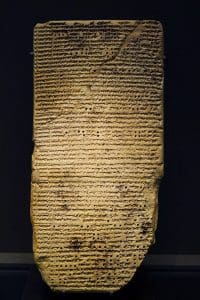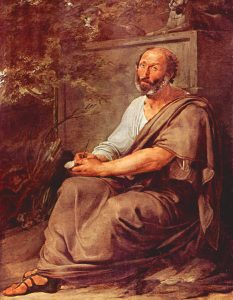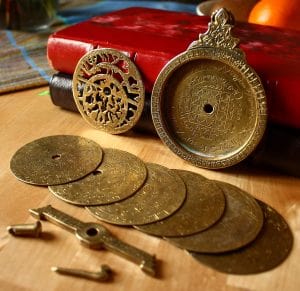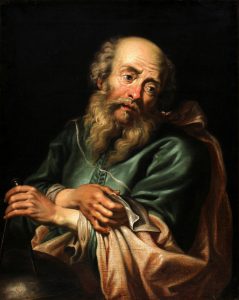By John Gaines and Virginia Johnson
You know, because you've been told, that the Earth revolves around the Sun. You also probably know that planets other than our own have moons and the way to test to see whether or not something is true is by experimenting. Thousands of years ago, these things were not widely known. The heavens above were anyone's guess, and the way things were was just the way the gods had made them. It was felt there was no need to truly understand them or put them in any kind of order.
The Babylonians: Astrologers and Astronomers
And yet, this began to change in the early days of civilization. People in the land of Babylonia (Iraq and Syria in modern times) created a large city on the banks of the Euphrates River. From roughly 2300 to 1879 BC, Babylonia grew from a small town to a large city and at last became the capital of an empire. As it became a seat of power, Babylonia’s people started to ask questions about their gods and the world around them. How could they understand the will of the gods to predict what would occur in their future?
Astronomy began by serving the Babylonians not as a science but as a part of their religion. The Babylonians believed that the Universe was divided into six levels with three heavens, the topmost being a “heaven of stars” which the gods used to communicate with them. The planets of our solar system, which were believed to be the brightest “stars” in the night sky, were most important to them. Particular devotion was given to the movements of Jupiter, which they identified with their chief god Marduk, and Venus, associated with Ishtar, their goddess of war and love. The movements of Jupiter, Venus, and the other planets were believed to be messages from the gods rather than the gods themselves and were very important in Babylonian religion. These movements, perceived as omens, were used to predict many important things, such as crop failures and war and tended to be written in a “if (x planet/star) does this, then (y event) will occur” format. Priests would then perform various rituals, attempting to prevent the disaster.
Because the movements of the planets and stars were so important, Babylonians began to develop an exact science to analyze their positions. They began to examine the same planets and stars in the sky at different times of year and in different places. They created MUL.APIN, an early list of stars classified into constellations, at around roughly 1000 BC. They were the first to identify the solstices and equinoxes of each year with the rising of four constellations, which they identified with animals: “the Bull” for vernal equinox, “the Lion” for summer solstice, “the Scorpion” for autumnal equinox, and “the Goat” for winter solstice. Babylonians also developed a system of sophisticated geometry to predict the movements of planets, such as Jupiter/Marduk. Babylonia would eventually fall to the Persians in 539 BC and lose its power and independence, but its people would always be fascinated by the stars, and a newer group of scholars in Greece would learn from them.
The Age of the Greek Astronomers
The Greek scholars brought changes to the study of the stars. They were famous for their schools of higher knowledge, which were rather different from ours. Students would gather around a teacher, perhaps in a beautiful grove, and ask questions and discuss among themselves what might be the answers and the best ways to figure out those answers. Many of today's colleges still aspire to this way of learning.
Over the centuries, this model of discovery and debate brought many changes and new discoveries to the study of astronomy. Thales of Miletus was one of the first great mathematicians of Western civilization and the first (585 BC) to successfully predict the timing of an eclipse. Because the telescope had not yet been invented, many early debates centered around heavenly bodies that could easily be seen from Earth and what the structure of the solar system was. Heracleides of Pontus first proposed the concept that the Earth made a daily rotation, although he also believed that the Sun and the other planets orbited the Earth each day. This geocentric (Earth-centered) model of the solar system was the most popular theory of the solar system’s organization among the Greek philosophers, although it would be standardized and refined by a later astronomer, Ptolemy. Aristarchus of Samos was the first Greek philosopher to believe the solar system was organized around the Sun, rather than the Earth. The heliocentric (Sun-centered) model was very unpopular during Aristarchus’ lifetime, although it would inspire astronomers centuries later.
Ptolemy
Ptolemy was an astronomer and mathematician. He believed that the Earth was the center of the Universe. The word for Earth in Greek is geo, so we call this idea a "geocentric" theory. Even starting with this incorrect theory, he was able to combine what he saw of the stars' movements with mathematics, especially geometry, to predict the movements of the planets. His famous work was called the Almagest. To make his predictions true, he decided that the planets must move in epicycles (smaller circles) and the Earth itself moved along an equant. None of this was true, but it made the math work for his predictions. This flawed view of the Universe was accepted for many centuries.
Aristotle
He is sometimes called the grandfather of science. Aristotle (384 BC–322 BC) studied under the great philosopher Plato and later started his own school, the Lyceum, at Athens. He, too, believed in a geocentric Universe and that the planets and stars were perfect spheres, though Earth itself was not. He further thought that the movements of the planets and stars must be circular since they were perfect and, if the motions were circular, then they could go on forever. Today, we know that none of this is the case, but Aristotle was so respected that these wrong answers were taught for a very long time. Outside of astronomy, Aristotle was a champion observer. He was one of the first to study plants, animals, and people in a scientific way, and he did believe in experimenting whenever possible and developed logical ways of thinking. This is a critical legacy for all the scientists who followed him.
Another Greek, Eratosthenes (c. 276 BC–192 or 194 BC), used geometry to calculate the circumference of the Earth. He is also known as the Father of Geography. You can read more about him in Measuring the Earth.
Beyond the West: The Time of the Islamic Astronomers
The Greco-Roman world, which had been a seat of higher learning and philosophy for centuries, would finally begin to fall into decline during the Crisis of the Third Century, a period of war and instability that would be the beginning of the end of Rome’s interest in higher learning. Rome’s power would last for a few more centuries, finally ending in 476 AD. People across the Western world had little time for the deep thought and theory they once did, and interest in astronomy was lost in many places. But a new culture would preserve the knowledge of the Greek astronomers and make new discoveries from the heavens as well. The time of the Islamic astronomers had begun.
The foundation of Islamic astronomy was the work of Ptolemy. After the fall of the Roman Empire, the text of the Almagest was translated from Greek into Arabic by 827 AD and became influential among Islamic astronomers. The early Islamic astronomers followed Ptolemy’s concept of a geocentric system but began to find flaws in his mathematical calculations. For example, Ptolemy had calculated that the earth’s “wobble,” or precession, changed 1 degree every 100 years. Ibn Yunus (950-1009 AD) corrected this to 1 degree every 70 years, which has been used ever since. The sophisticated geometry the Babylonians once used, ignored by the Greeks, was adopted and surpassed by Yunus, who used trigonometry to calculate 40 planetary conjunctions and 30 solar eclipses.
One of the most important works of Islamic astronomy was the Book of Fixed Stars. This was a star catalog that was written by Abd al-Rahman al-Sufi (Azophi) around 964 AD. What made this book special was that it was not merely a translation of Ptolemy’s Almagest into Arabic, but it was a considerable expansion that incorporated Arabic constellations into Ptolemy’s earlier work. The Arabic constellations were traditionally used by Bedouin travelers who needed to cross long distances over land, especially the Silk Road trade route. The Book of Fixed Stars was the most in-depth description of the night sky available, and it was also one of the first star catalogs to feature illustrations to make reading easier. The Arabic names of many stars would be retained as the book became influential in the Western world, and, to this day, most bright stars still have names derived from Arabic.
Abu Ma’Shar was a very influential Islamic astronomer who is believed to have written 50 books on astronomy while he was in the court of Baghdad. It was he who translated Ptolemy’s Almagest from Greek to Arabic and gave it the Arabic name it is referred to even in modern times. Abu Ma’Shar’s interest in astronomy was linked to his interest in astrological predictions and horoscopes, and he thought that the movements of the stars could predict human actions. He believed that each star had some influence over a specific aspect of the Universe, and that their precise movements would influence human behavior and natural events. Though his works on astronomy were lost, his texts on astrology and translation of the Almagest both survived and were translated to Latin, entering the Western world’s knowledge.
The Golden Age of European Astronomy
As Islamic star catalogs, astrological texts, and translations of the work of Greek philosophers became available in Latin, a new age of learning and discovery began across Europe. An interest in classical philosophy and science was rekindled, and the Renaissance began. This period would see new astronomers rise up and challenge the centuries-old geocentric theory, aided by the invention of the telescope. Astronomers would see the Universe in far more detail than ever before.
Copernicus
A little over 500 years ago, Nicolaus Copernicus came up with a radical way of looking at the Universe. His heliocentric system put the Sun (helio) at the center of our system. He was not the first to have this theory. Earlier starwatchers had believed the same, and, in fact, Copernicus cited Aristarchus of Samos as an inspiration, but it was Copernicus who brought it to the world of the Renaissance and used his own observations of the movements of the planets to back up his idea. His ideas, including the revelation that the Earth rotates on its axis, were too different for most of the scholars of his time to accept. They used only parts of his theory. Those who did study his work intact often did so in secret. They were called Copernicans.
Galileo
Born in Pisa, Italy, approximately 100 years after Copernicus, Galileo became a brilliant student with an amazing genius for invention and observation. He had his own ideas on how motion really worked, as opposed to what Aristotle had taught, and devised a telescope that could enlarge the visibility of objects up to eight times their original size. After a later upgrade, it could enlarge objects up to 20 times. One of the earliest discoveries Galileo made with his telescope was the nature of the Moon’s surface; he discovered many craters, fissures, and hills on the Moon, contrary to the earlier concept of the Moon as a “perfect” heavenly object. He would be the first to observe that the Milky Way was actually a group of stars, rather than clouds in the night sky. Galileo also discovered Jupiter’s moons and observed the phases of Venus in 1610.
He was able to use this telescope to prove the truth of the Copernican system of heliocentrism. He published his observations which went against the established teaching of the Church. He was brought to trial and, although he made a confession of wrongdoing, he was still kept under house arrest for the rest of his life. But it was too late to lock away the knowledge that Galileo shared. Other scientists, including Sir Isaac Newton and Johannes Kepler, seized its importance and were able to learn even more about the ways of the world and the heavens beyond.
These early scientists' legacies continue to this day. As time goes on, we use our instruments, science, math, reasoning, and creativity to learn more about the secrets of the Universe. In this way, we are directly linked to the astronomers of times past who gave us direction to discover more about the dances of the planets and the nature of the stars.
In the Library and on the Web
Discovery of the Solar System
This site from NASA follows the development of ideas about the solar system from Ptolemy to Copernicus to Galileo.
Makers of Science
Volume one of this reference set has information on Aristotle, Copernicus, and Galileo.
Recentering the Universe
An 88-page round-up of how these early scientists' work changed everything about people understood their world.
Articles on many early astronomers can be can be found in our online databases: Biography in Context and Encyclopaedia Britannica (English, Spanish, and children's versions).
Aristotle
Aristotle Leads the Way
Captures the life and times of Aristotle, the ancient Greek philosopher who studied a wide range of subjects and helped shape early scientific beliefs. In our young adult collection.
Aristotle
Contents: Among the trees of Athens -- Life in ancient Athens -- Life in the king's court -- Investigating the natural world -- Return to Greece -- Thinking about thinking -- On Earth and the heavens above -- On right and wrong -- Impact of Aristotle -- Life and times -- Life at a glance.
The Great Thinker
Stresses the importance of Aristotle's intellectual discoveries on the future of science.
Biography for Kids: Aristotle
A short online biography of Aristotle good for upper elementary grades that touches on some important points.
Copernicus
Copernicus
An enjoyable 128-page biography of the 16th-century Polish scientist that includes activities on retrograde motion, the solar system, parallax, and an astrolabe.
Nicolaus Copernicus
The center of the universe -- A childhood in Poland -- A long-term student -- In the service of the church -- Look to the stars -- The Copernican theory -- Late in life -- A scientific revolution -- Late in life -- Life at a glance.
The History News in Space
Uses a newspaper format to take a look at developments that led from the ideas of Copernicus and other early scientists to the technological advances that enabled man to venture to the moon and beyond.
Nicolaus Copernicus: Making the Earth a Planet
This eBook from Oxford University Press is targeted to high school students and above. Click here, opens a new window for information on accessing our EBSCOhost eBook collection.
Galileo
Galileo
A biography of 17th-century Italian astronomer and physicist Galileo that includes related activities for readers.
Galileo for Kids
This biography has experiments and activities as well as his life story.
Starry Messenger
A beautiful retelling, in picture book format, of Galileo's story which can be used with both younger and older audiences.
The Galileo Project
A hypertext online source of information on the life and work of Galileo Galilei (1564-1642) and the science of his time. Includes a biography, letters from his daughter, and a tour of his home. From Rice University.
Galileo's Battle for the Heavens
An online timeline of his life, articles on his place in science and his telescope, his mistakes on predicting the tides, a teachers' guide, and interactives on his experiments with falling objects, projectiles, inclined planes, and pendulums
Who Was Galileo?
A 105-page biography with illustrations and maps. Part of the "Who Was" series. Also available on eAudio.
Ptolemy
Ptolemy's Contributions to Geography Roman Scholar Claudius Ptolemaeus
A bit on Ptolemy's life and more about his accomplishments.
Ptolemy's World
Lots of illustrations of Ptolemy's geography, a note on his principle of simplicity, and links to his texts.






